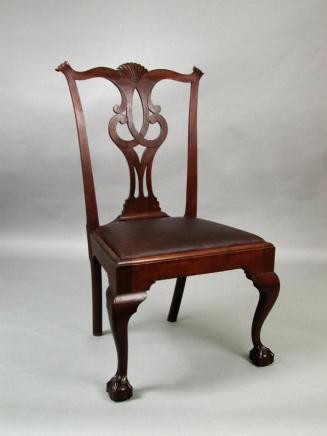Dining Table
Furniture MakerPossibly made by
Amos Denison Allen
(American, 1774 - 1855)
Original OwnerOriginally owned by
Ebenezer Waldo
(American, 1766 - 1843)
Original OwnerOriginally owned by
Eunice Huntington Devotion
(American, 1770 - 1854)
Dateabout 1797
MediumCherry primary wood, tulip poplar secondary wood
DimensionsPrimary Dimensions (height x width x depth of top when open): 27 7/8 x 94 1/8 x 47 3/4in. (70.8 x 239.1 x 121.3cm)
ClassificationsFurniture
Credit LineMuseum purchase
Object number1988.51.0a-c
DescriptionCherry dining table in the Federal, or early neoclassical, style. The dining table consists of two identical, semi-circular end sections (.a, .b) and a center rectangular table with falling leaves (.c), or swing-leg table. The top of each end section is semi-circular, and supported by a frame with three curved and veneered rails, one at the front and each side, and a straight back rail. There is a tapered leg at each back corner and two at the front, between the three curved rails. The center section is a swing-leg table, consisting of a rectangular stationary center section joined with hinges to a rectangular leaf on each side. The frame has four rails at the top, and six tapered legs. Each corner of the rectangular frame has a stationary leg, and each long side has an additional swing leg that supports the leaf when open.
Condition: One end section (.a) has several overlapping dark rings on the top, and a few small gouges. The other end section (.b) has several dark overlapping impressed rings and small gouges on the top, and several repairs: one diamond-shaped, nine small circular plugs. The center section (.c) has L-shaped metal brackets joining the top to the frame; most of the glue blocks are missing. There are several small gouges on all three sections of the top. The center has a split down the middle, and seven small circular plugs. One leaf has deeper gouges and cluster of deep scratches. The other leaf has three longer gouges and pieces of wood missing from the lower outer edge. The legs have overall light wear and scratches, especially at the corners.
Design and Construction Details:
Each End Section. The top of each end section is constructed of two boards that are butted together. It is joined to the frame with screws through the frame and the underside of the top. A rectangular glue block is glued to the underside of the top at both the center front and back of the frame of each end section. Each curved rail is brick built, or constructed of six horizontal, curved layers of wood that are laminated together; the exterior surface of the curved rails are veneered. The curved rails and straight back rail are tanoned into the top of the full height leg post. Small vertical glue blocks reinforce the interior of the joint between each curved rail and the front legs. Larger vertical glue blocks reinforce each interior joint between the back rail, each back leg, and side curved rails.
Center Section. The stationary center section and each leaf of the top is constructed of a single board. Each leaf is joined to the stationary center section with two hinges along a rule joint. The top was originally joined to the frame with rectangular glue blocks along all four interior sides of the top of the frame; these are now missing and the top is joined to the frame with L-shaped brackets screwed to the frame and top. The rectangular frame is constructed or two short side rails and two long side rails. Each short side rail is tenoned into the top of the stationary leg posts; the interior corner is reinforced with a vertical glue block. Each long side rail consits of an interior and an exterior rail. Each interior long side rail is tenoned into the top of the leg post. Each exterior long side rail is constructed of four parts. At each end is a short vertical block that is tenoned to the top of the leg post. The longer center section of the rail is constructed of two halves. The left half is stationary, and is nailed from the inside to the interior long side rail. The right half is is tenoned, or possibly dovetailed, to the top of the fly leg. This fly rail and fly leg pivot on a knuckle joint where the two center sections join in the middle of the long side of the frame. The top of the fly leg and rail are cut out to fit smoothly into the exterior long side rail when the top is closed.
Condition: One end section (.a) has several overlapping dark rings on the top, and a few small gouges. The other end section (.b) has several dark overlapping impressed rings and small gouges on the top, and several repairs: one diamond-shaped, nine small circular plugs. The center section (.c) has L-shaped metal brackets joining the top to the frame; most of the glue blocks are missing. There are several small gouges on all three sections of the top. The center has a split down the middle, and seven small circular plugs. One leaf has deeper gouges and cluster of deep scratches. The other leaf has three longer gouges and pieces of wood missing from the lower outer edge. The legs have overall light wear and scratches, especially at the corners.
Design and Construction Details:
Each End Section. The top of each end section is constructed of two boards that are butted together. It is joined to the frame with screws through the frame and the underside of the top. A rectangular glue block is glued to the underside of the top at both the center front and back of the frame of each end section. Each curved rail is brick built, or constructed of six horizontal, curved layers of wood that are laminated together; the exterior surface of the curved rails are veneered. The curved rails and straight back rail are tanoned into the top of the full height leg post. Small vertical glue blocks reinforce the interior of the joint between each curved rail and the front legs. Larger vertical glue blocks reinforce each interior joint between the back rail, each back leg, and side curved rails.
Center Section. The stationary center section and each leaf of the top is constructed of a single board. Each leaf is joined to the stationary center section with two hinges along a rule joint. The top was originally joined to the frame with rectangular glue blocks along all four interior sides of the top of the frame; these are now missing and the top is joined to the frame with L-shaped brackets screwed to the frame and top. The rectangular frame is constructed or two short side rails and two long side rails. Each short side rail is tenoned into the top of the stationary leg posts; the interior corner is reinforced with a vertical glue block. Each long side rail consits of an interior and an exterior rail. Each interior long side rail is tenoned into the top of the leg post. Each exterior long side rail is constructed of four parts. At each end is a short vertical block that is tenoned to the top of the leg post. The longer center section of the rail is constructed of two halves. The left half is stationary, and is nailed from the inside to the interior long side rail. The right half is is tenoned, or possibly dovetailed, to the top of the fly leg. This fly rail and fly leg pivot on a knuckle joint where the two center sections join in the middle of the long side of the frame. The top of the fly leg and rail are cut out to fit smoothly into the exterior long side rail when the top is closed.
Status
Not on view








